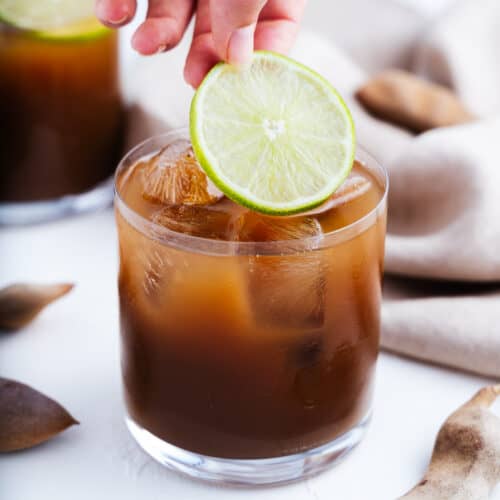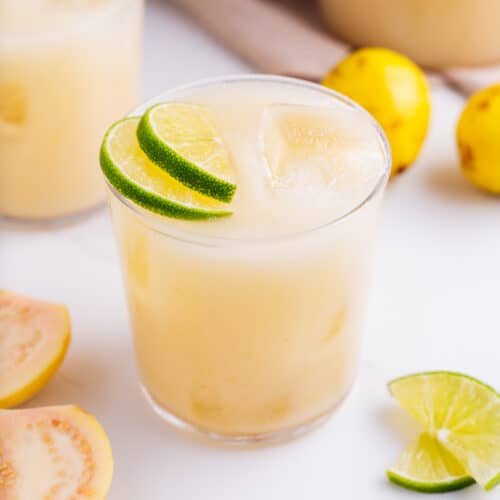Agua de Pina
Agua de pina, or pineapple water, has the perfect balance of sweet, tropical, and refreshing flavors. This 3-ingredient recipe is quickly going to become your new favorite way to cool off after a day in the sun!

Learning how to make agua de pina is a breeze, and it’s a great way to hydrate and treat yourself at the same time. If you’re in the mood for more classic aguas frescas, don’t miss my equally refreshing agua de jamaica and horchata recipes!
Why I love this recipe
This agua de pina requires just 3 ingredients and a blender, making it one of my favorite budget-friendly ways to cool off in the summertime. With pineapple as the star ingredient, it delivers a balanced sweet, tangy, and tropical flavor.
Preparation couldn’t be easier, either! All you need is 15 minutes, making it ideal for impromptu gatherings with friends and family. People of all ages love this beverage, and it’s easily scalable for a single serving or large get-togethers. Let’s get blending!
Ingredient notes
Depending on how ripe your pineapple is, you may not even need a sweetener for your agua de pina recipe. Find an ingredient breakdown and suitable substitutes below!

Pineapple
I prefer fresh pineapple for a tropical sweetness and a vibrant tartness that can’t be beaten. If you don’t have access to fresh pineapple, an equivalent amount of frozen pineapple will work.
Substitute: For an equally refreshing flavor, try mango or papaya, though these fruits will offer a different sweetness and less tang.
Cane sugar
Adds a delicate sweetness, complementing the pineapple’s tartness and balancing the drink’s overall flavor without overpowering it. Start with a smaller amount and adjust the sweetness according to your preferences and the ripeness of the pineapple.
Substitute: Agave or maple syrup will also work, or you can use stevia or monk fruit as a sugar-free option if you prefer.
For a complete ingredient list and step-by-step guide, scroll down to the recipe card.
How to make
Learn how easy it is to make agua de pina with my step-by-step instructions. Look for the tips in green throughout this section for consistent and successful results! Also, you can watch my video tutorial down below!
Preparation
Start by washing the pineapple thoroughly. Lay it on its side and cut off the top and bottom to create a stable base. Stand the pineapple up and slice away the skin in strips, following the curve of the fruit. Then, remove the eyes and chop it into chunks.
Try to preserve as much fruit as possible while removing all the hard, spiky skin. The core is tougher than the flesh, but it’s full of flavor and blends well, so you can include it in your chunks.
Assembly
Step 1
Add the chopped pineapple, water, and cane sugar to a blender. At this point, you can add optional flavorings like fresh ginger, lime juice, or coconut water.
For a smoother agua de pina, start your blender on low to break up the big chunks, then gradually increase to high speed to fully liquefy the mixture.

Step 2
Blend the mixture on high until no chunks remain and the consistency is smooth. Taste and adjust the sweetener, then strain the mixture into a bowl, jar, or pitcher to remove the pulp.
If the mixture is too thick or too sweet, add more water or coconut water to dilute it. If it’s not sweet enough, add more sweetener, but do it gradually.

Step 3
Transfer what’s left of the mixture to your fridge to chill, or serve it immediately over ice. Happy drinking!

Expert tip
For the best-tasting agua de pina, focus on the quality and ripeness of your pineapple. A ripe pineapple is key to achieving the perfect balance of sweetness and tartness.
When you’re selecting a pineapple, look for one that has a golden-yellow color, feels slightly soft to the touch, and has a sweet, fragrant aroma at the base. This means your agua de pina will have a naturally sweet flavor, minimizing the need for excess sugar or other sweeteners.
If you’re adding optional ingredients like ginger or lime, use them sparingly at first. These flavors should complement, not overpower, the pineapple’s natural zest.
Recipe tips
Blend until smooth: Blend the mixture until it’s completely smooth for the best drink experience. If necessary, stop and scrape down the sides to catch all the chunks.
Sweeten slowly: Adjust the sweetener according to the pineapple’s natural sweetness. If it’s sweet enough, omit the cane sugar altogether.
Strain the mixture: Use a fine-mesh strainer to remove pulp for a smoother drink.

Frequently asked questions
Straining the pineapple mixture is optional, but I recommend it for a smoother agua de pina texture.
You can use canned pineapple in juice for more convenience, but fresh pineapple will provide the best flavor.
Yes, but a blender will typically result in a smoother consistency. If you use a food processor, make sure you strain the mixture.
Storing
Agua de pina is best enjoyed fresh, but you can store it in the fridge for about 1-2 days. To preserve the best flavor, keep it in a sealed container, such as a glass pitcher or mason jar with a lid.
You can also freeze leftovers in ice cube trays for later use or as a way to chill other drinks. If you have frozen cubes, let them thaw in the fridge overnight or blend them and serve them directly as a slushy.
Watch how to make it
More aguas frescas
Hungry for more?
If you enjoyed this recipe, please consider leaving a star rating and a comment down below! Your feedback not only helps others discover our blog but also gives us valuable insights from your experience.
Don’t forget to subscribe to our newsletter for the latest recipes, and check out our shop for our top kitchen recommendations. Thank you for supporting BBV!
Recipe

Easy Agua de Pina (3 Ingredients)
Equipment
- Knife & cutting board
- Blender
- Strainer
- Pitcher or jar
Ingredients
- ½ medium fresh pineapple, peeled and cubed
- 33 ounces water
- 3-4 tablespoons cane sugar or agave
Add-ins
- Ice
- ½ inch fresh ginger, peeled
- 1-2 tablespoons lime juice
- 1-2 cups coconut water
Instructions
- First, peel and roughly cut the pineapple into chunks.
- Add the pineapple, water, and cane sugar to a blender. At this point, you can add optional ingredients like fresh ginger, lime, or coconut water in place of plain water.
- Blend on high until no chunks remain and the mixture is smooth. Taste and adjust the sweetener to your preferences.
- Strain the mixture into a bowl, jar, or pitcher to remove some of the pulp.
- Transfer to your fridge to chill, or serve immediately over ice. Happy drinking!
Notes
Nutrition
Note: I’ve updated this post to include new information and helpful tips about the recipe.
Justine Drosdovech is a food writer, photographer, and one of the founders of Broke Bank Vegan. She is a self-taught plant-based chef but uses her healthcare background to craft dishes that are both delicious and nourishing.






Refresco! If that’s a word…
Refrescante! Glad you think so 🙂